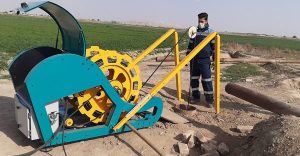The device that produces air pulses is known as a “gun” and is used for rehabilitating aged water and oil boreholes. This system works by suddenly releasing compressed air which creates unstable bubbles that grow until they burst. The resulting explosion creates mechanical waves that reveal the sedimentation that has been deposited onto the well screen’s perforations. Our field research has demonstrated that after well rehabilitation using Nitro-Pulse® technology not only will the sediment be descaled but the permeability of the filter pack will also be enhanced increasing the water yield of the borehole.
It is important to note that when utilizing this technique the entire water column within the borehole should be subjected to the shocks of the gun to thoroughly recover the borehole to its primary condition. The air pressure range is from 15 to 200 bars and the number of pulses ranges from 10 to 20 pulses per minute. Additionally in some situations nitrogen gas can be used instead of air.
Nitro-Pulse® is a service available only to a limited number of companies worldwide. Reports and data from well rehabilitation projects using this technology show that it can improve the water yield of a well by up to 60%. The technique has several advantages including operator-controlled operation the ability to penetrate the filter pack fast operation and environmental friendliness.
This technology is capable of being used for boreholes with stainless steel UPVC and Johnson casing with a diameter ranging from 6 to 24 inches. It can be utilized for boreholes that have depths of up to 850 meters. For example if a borehole has a 50-meter water column approximately 1500 to 2500 compressed air shots are needed to influence all parts of the borehole.

